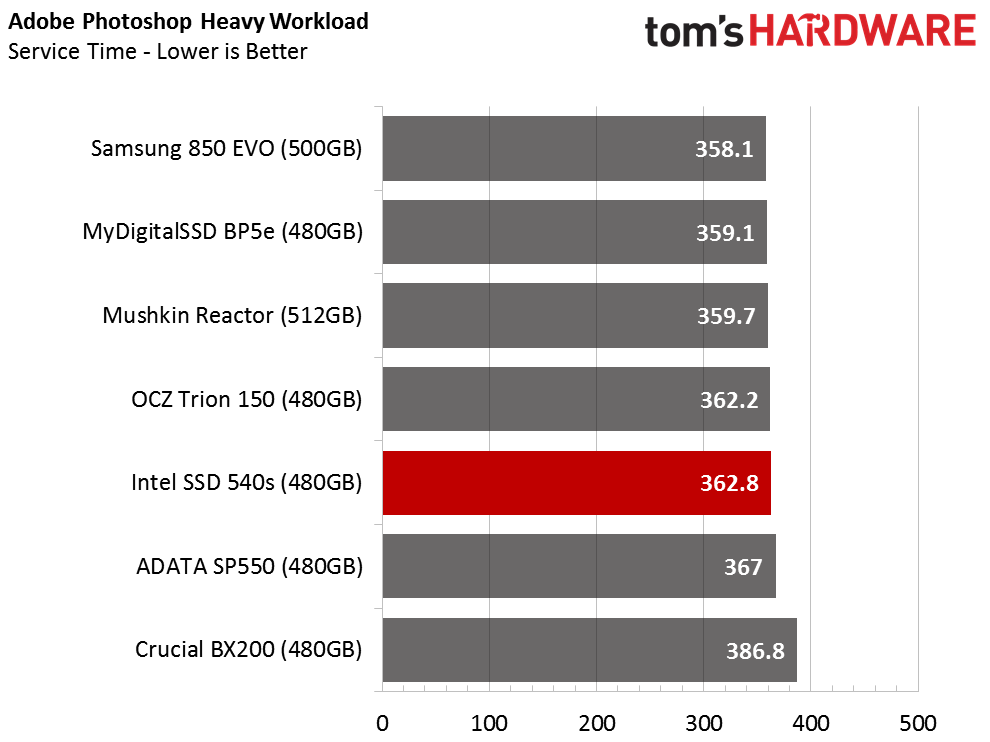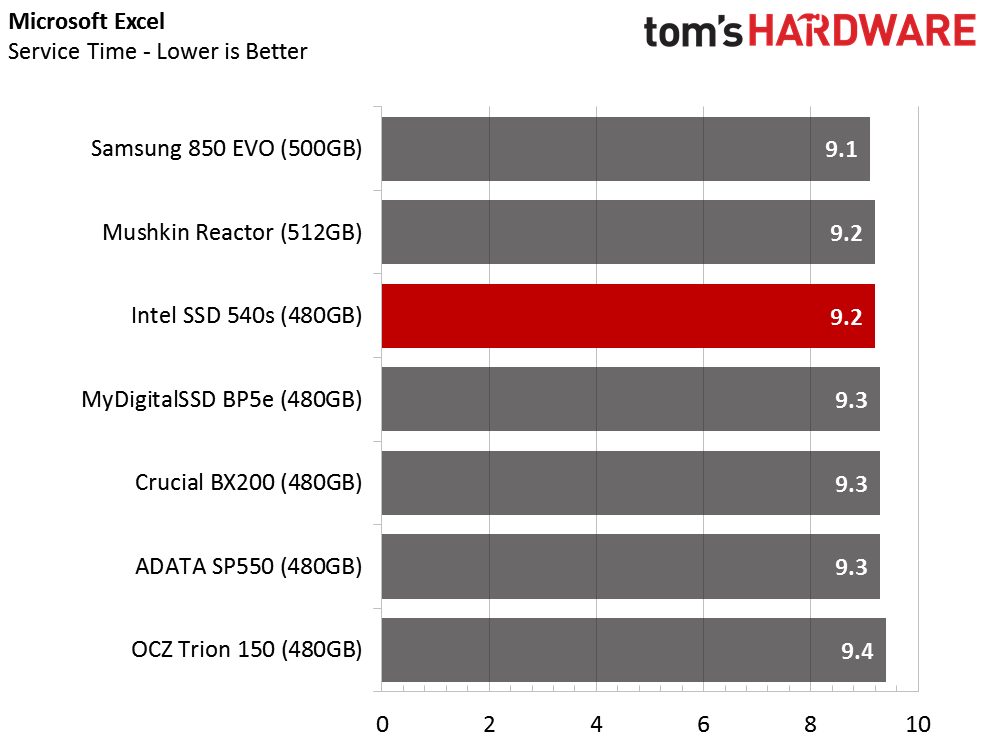Intel SSD 540s Review - Our First Look At The SM2258
Intel scored SMI's new SM2258 controller under an exclusive contract and paired it with SK hynix 16nm TLC flash for the new SSD 540s. Intel geared the 540s to attack the low-cost segment, but performance is always a key issue, so let's put it to the test.
Why you can trust Tom's Hardware
Performance And Conclusion
PCMark 8 Real-World Software Performance
For details on our real-world software performance testing, please click here.










The Intel SSD 540s delivers mixed results with real world trace-based tests. The drive settles in the middle of the performance list in some of the tests, and it falls to the bottom (or near the bottom) of the charts in other tests. Loading Photoshop images appear to be difficult for the 540s. The heavy amount of write data generated during those two tests pushes the drive past the SLC write buffer, which makes the native TLC performance a big factor.
We see exactly where the Intel SSD 540s 480GB sits in relation to the other products when we average the results and normalize scoring with an easily digestible throughput figure. The drive fails to deliver the same performance as the Adata SP550 that employs the previous-generation SM2256 controller. The Phison S10-based BP5e is also slightly faster. The class-leading Samsung 850 EVO speeds away from all of the other drives in the chart and is nearly 100 MB/s faster than the 540s.
PCMark 8 Advanced Workload Performance
To learn how we test advanced workload performance, please click here.



The Intel SSD 540s performs a little better when the SSD is full. We show both heavy workloads (with idle time to recover) and moderate workloads (with a 5-minute pause for the SSD to recover and perform background activity), but we only focus on the moderate portion of the test.
You can see that most of the true entry-level products perform about the same with ample recovery time. The 850 EVO 500 GB stands out again, which highlights why it is the leader in this market segment.
Total Access Time



The 850 EVO and BP5e deliver the best access time measurements during moderate use, but the Intel SSD 540s is not far behind. The 540s is not very competitive for most users given the other products on the market and the difference in price.
Get Tom's Hardware's best news and in-depth reviews, straight to your inbox.
Disk Busy Time
The Disk Busy Time test results measure the amount of time that the drive is working, rather than just the time it is in an idle or low power state. We don't always publish the results of the test, but they help to explain the notebook battery results in the next section. The Intel SSD 540s takes longer to complete the tasks than most of the other products on the chart, which means it takes longer to go back into the power-sipping slumber mode.
Notebook Battery Life


I didn't expect great notebook battery life performance from the Intel SSD 540s after I noticed the high disk busy time measurements. It became clear that our expectations met reality after the test completed. It's almost as if Intel set aside all of the attributes we've come to love about the company's SSDs to get a lower-cost, consumer-friendly product to market.
Conclusion
It's important to understand why a company releases a product. Intel sells many different products and has an entire constellation of partners to work with. The SSD 540s doesn't appear to be a competitive mainstream SSD on the surface, but that may not be the reason it exists. Intel often bundles other components with its processors and partner motherboards. The 540s may be a "big picture" SSD, and not just a failed attempt to take on Samsung in the mainstream SSD market.
As a mainstream SSD, the 540s is just not competitive in either price or performance. Intel has gotten away with selling SSDs for a higher price than most competitors, but for the strategy to work the company has to give the product the performance to go with it. I have no doubt that the SSD 540s is a very reliable product, but I can say the same thing about the Samsung 850 EVO, and there is years of reliability data to prove it.
The SSD 540s really should have entered the market as an entry-level 3-Series product with a price to match. Currently, competitive entry-level SSDs at this capacity sell for $120 or less. Intel is not the only SSD vendor to make the same mistake. Several of the large corporations are cutting costs and delivering less value than Tier 2 and Tier 3 SSD manufacturers.
Name recognition alone doesn't do much for me. I view success with previous products as history. When you stand in front of a roulette wheel and see six straight black landings, that don't mean the next one will be red. The previous roll doesn't have much to do with the next in roulette, and the same goes for consumer SSDs.
Intel puts its consumer SSDs through stringent testing, but the company has also delivered products with reliability issues in the past. I would go as far as to say that Intel has one of the best, if not the best, records for SSD reliability. We have to wonder how the transition to a third-party controller and flash will affect that record, but we will have to let time tell that story.
We were a bit surprised to see the SSD 540s ship with SK Hynix flash instead of the new IMFT 3D NAND. Crucial has already announced the MX300, a mainstream-tier product, with IMFT 3D flash running in 3-bit-per-cell mode. For the past year, rumors have swirled that the IMFT (Intel/Micron) relationship has turned sour, and Intel has even announced it is building a new fab to produce 3D NAND. The timing of the Intel SSD 540s and Pro 5400s coming to market with SK hynix NAND will lead to even more speculation about the state of the relationship.
MORE: Best SSDs
MORE: How We Test HDDs And SSDs
MORE: All Storage Content
Follow us on Facebook, Google+, RSS, Twitter and YouTube.

Chris Ramseyer was a senior contributing editor for Tom's Hardware. He tested and reviewed consumer storage.
-
joz Was the OCZ Trion 150 and Mushkin Reactor always that good? While they aren't the Evo, they seem to be performing quite well.Reply -
boller Guys, you've misread "native TLC transfer performance" as being 135MB/s. In fact it's even worse - about 125 MB/s (from eyeballing the graph).Reply
135MB/s is average speed which includes SLC bump in it's calculation.
But it does not change the conclusion, of course: this drive is POS. -
anonymousdude Pricing on amazon is high, well at least it is if you live near a microcenter. If you order from microcenter the 480gb is priced at $120, which is $10 more than the trion 150 which $110 at microcenter and is $120 on amazon. I'd say that at it's a fair price considering Intel's reputation for reliability and well Intel's branding. For reference the 850 evo is $158 on amazon and $150 at microcenter. Not saying that it's a good drive, but to an average person price and reliability are going to matter more than the fact that it slightly slower than some other drives.Reply -
dreamer2908 Reply18452087 said:Was the OCZ Trion 150 and Mushkin Reactor always that good? While they aren't the Evo, they seem to be performing quite well.
Well, Mushkin Reactor uses the same controller (SM2246EN) and NAND (Micron 16nm MLC) as Crucial BX100 does.
The discontinued BX100 performed quite well, so the Reactor should also do. -
Zaxx420 "it doesn't give us a reason not to buy a Samsung 850 EVO."Reply
Bet you have a keyboard macro just for that phrase...lol -
Cyberats Wow, Mushkin Reactor is my surprise in this survey, stable on all fronts where even Samsung Evo is wavering and it's a full 512gb of space or is it a typo ?Reply -
littleleo I would have liked to see the SK Hynix model in the mix the price on those is good and the performance according to my customers is also very good. The specs look better then the Samsung's on the read and worse on the write; I just wish they offered a 1TB version.Reply -
mapesdhs C.R., I thought toms was going to stop using graphs with non-zero origins? The sequential read and notebook battery life graphs are visually misleading. There's no point using a graph if its visual appearance does not convey data difference.Reply


